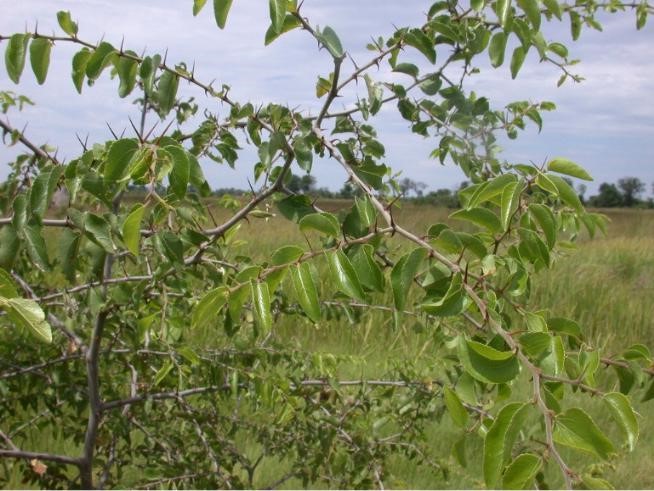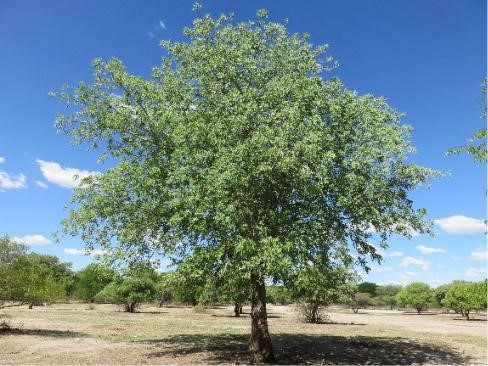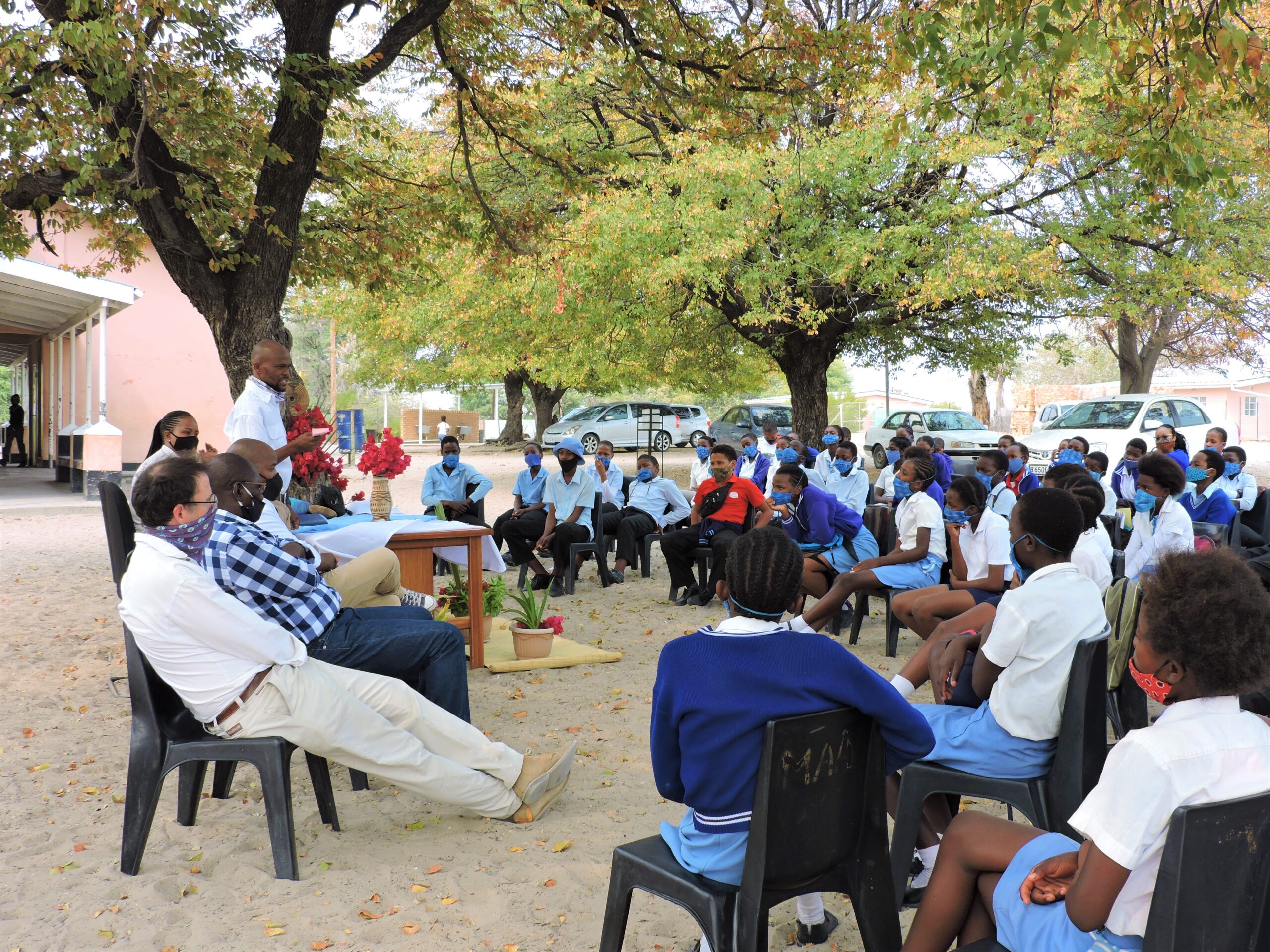Mokgalo is one of the Setswana names for Ziziphus mucronata Willd. subsp. mucronata in the Family Rhamnaceae. The family is commonly called Buckthorn, perhaps this helps explain why one of the English common names for Mokgalo is ‘Buffalo Thorn’?! The Afrikaans common name for this tree is ‘wag-‘n-bietjie’ meaning wait a bit which is explained by the thorns (which snag you) that are often paired and are unusual in that one thorn is straight and the other curved backwards. People say this is to remind you, while you unsnag yourself from its clutches, to think about where you’re going and where you’ve come from.
Other names for this tree are, in Kalanga: nchecheni, in Subiya: mokalu and in Hambukushu: mokeketi. Ziziphus mucronata is a small tomedium-sized tree, 3-10m high, with a spreading canopy. The leaves are simple, alternate, ovate or broadly ovate and may vary enormously in size from tree to tree. The leaf tips taper and are often ‘mucronate’ at the tip.
Mucronate means ending abruptly in a short sharp point or ‘mucro’. Actually, the leaf base is more defining as it is strongly asymmetrical, cordate to rounded on one side. The leaf margin finely serrated, often eaten by insects, glossy green above, slightly hairy and paler below; 3- to 5-veins from the base. Leaves turn golden yellow in autumn and drop leaving a crunchy layer on the ground whilst the fruit often remain on the tree. Flowers are small borne in dense clusters in leaf axial, green to yellow, 4mm in diameter and inconspicuous. The fruit is a smooth, shiny, leathery, single seeded spherical drupe, 12-20 mm in diameter, reddish-brown or deep red when ripe, slightly sweet.
Buffalo Thorn is distributed throughout sub-Saharan Africa, extending from South Africa northwards to Ethiopia and Arabia. It grows in areas dominated by thorny vegetation in both temperate and tropical climates. It is also found in a wide range of habitats such as woodlands, open scrubland, on rocky koppies, open grasslands, on a variety of soils along streams, nutrient-rich valley bottoms and forest margins. It reaches its largest size on the margins of scrub forest and on deep, alluvial soils near water. In and around the Okavango Delta you’ll see them standing out, along with Ficus sycomorus (Mochaba), on newly formed floodplains. These two trees can withstand longer periods of flooding than many other woody species.
Although the fruit of Ziziphus mucronata are not tasty, the tree itself plays an important role ecologically. The leaves and fruit are sought after by birds of many species, wild animals and domestic stock. Giraffes are known to be especially fond of the leaves of this tree. Impala often feed on the dead leaves lying under the tree.
Scientific studies have shown that Z. mucronata has cyclopeptide alkaloids(mucronines) with antibacterial properties. Those properties are probably why the tree provides many traditional herbal medicinal remedies. A decoction of the glutinous roots has been commonly administered as a painkiller, whilst a concoction of the bark and the leaves were used for respiratory ailments and septic swellings of the skin.
The tree is used for many purposes, some Africans drag a branch around the village to protect it from evil spirits. In Botswana as well as most parts of South Africa, the residents believed the Buffalo Thorn to be immune against lightning, anyone standing under one in a storm would be safe. Hambukushu and Batawana eat the fruit and use them for brewing. Young Wayei men take an infusion of the roots of young plants to make them sexually strong. Wood from this tree is used for timber, wagon making and fence posts as it yields a yellow, fine-grained, heavy wood which contains a lot of tannin. The elasticity of the shoots makes it suitable for bows and whip sticks. Some African tribes use the thorny branches to make kraals or hedges to protect their livestock from lions and other predators.
Globally, economic uses of the Rhamnaceae are chiefly as ornamental plants and as the source of many brilliant green and yellow dyes. The wood of Rhamnus (a European relative of our Ziziphus) was also the most favoured species to make charcoal for use in gunpowder before thedevelopment of modern propellants.
About us: PSUB herbarium at Okavango Research Institute
This article was written by Frances Murray-Hudson and Joseph Madome, the Curator at PSUB herbarium at the Okavango Research Institute which is part of the University of Botswana. PSUB has an ongoing project called ‘Data Mobilization’ which means that we are digitally scanning plant specimens that have been dried then mounted on herbarium sheets. We then extract information from the labels into our database BRAHMS. This work at PSUB is funded by Chobe Holdings’ Desert and Delta Safaris’ Xugana Island Lodge.
The vegetation of the Okavango delta is the anchor of this unique environment. PSUB houses a legacy collection of flora specimens comprising a comprehensive, representative sample of the botany of the Okavango Delta, the World’s 1000th Heritage Site as declared by UNESCO in 20141.
If you would like to know more about the Flora of Ngamiland or the work at PSUB Herbarium, please contact: The Curator; Mr J Madome; madome@ub.ac.bw or PSUB Data Mobilization Assistant : Mrs F Murray-Hudson; fmurray-hudson@ub.ac.bw.








0 Comment